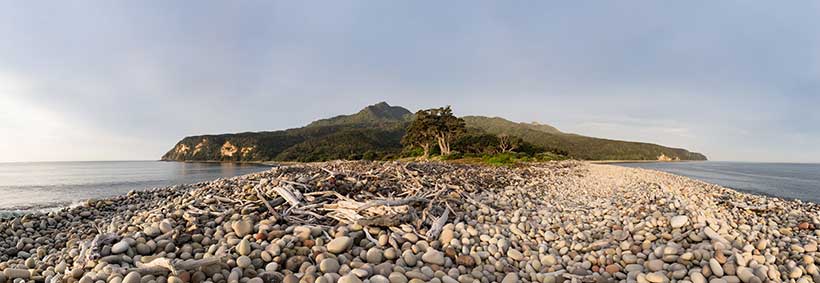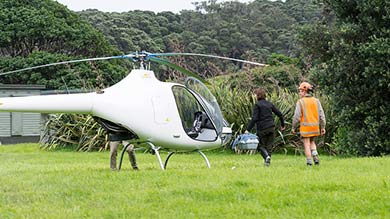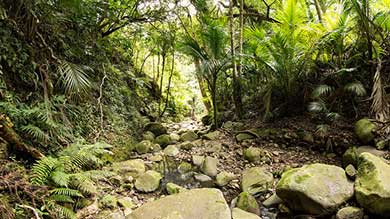As you might remember if you’ve been reading these blogs regularly, the team completed the standard transmitter change in April. Kākāpō transmitter batteries last a year, meaning that the next change would be due right in the middle of a potential breeding season. To avoid this, we have moved the transmitter changes to September, requiring an additional change this year.

Hauturu-o-toi
Image: Jake Osborne | DOC
The September trip to Hauturu also gave us an opportunity to check on the four birds who were transferred there in July: Blades, Wendy, Tia and Tiaka.
The full story of the transfer.
Following their release on the island, both Blades and Wendy settled back into their old home ranges, despite having not been there for 20 years! Tia and Tiaka have also settled in well and all four birds were in good health.
Hauturu is larger, and much, much steeper than either Whenua Hou or Anchor. It’s a lot harder simply getting to the area an individual kākāpō lives in and so an awful lot more disappointing if they can’t be caught. Having to complete a strenuous hike again and again to try and catch a bird can be hard on the team. Pleasingly, catching the birds progressed quickly this trip. Unusually for Hauturu there wasn’t a single day that a team returned unsuccessful after trying to catch a bird.
Only one bird caused us concern this trip. When Flossie was caught she was found to have a unusual lump in her throat, and another in her abdomen. Worried about the cause, she was flown off the island to Auckland Zoo to be assessed by the veterinary team. As the birds are only caught once per year we didn’t want to take the risk of ignoring a potential health issue. She was otherwise healthy and the lumps disappeared after several days. The vet team suspect that she’d been eating some large native fruits and so sent her back home again to be released. The resident rangers will carry out follow up checks just to be sure.

Flossie being loaded onto a helicopter to fly to Auckland
Image: Jake Osbourne | DOC

The almost tropical vegetation of Hauturu
Image: Jake Osborne | DOC
The males on Hauturu were in very good condition with Tiwai weighing in at a whopping 3 kg! This is great sign coming into summer.
We don’t know what triggers kākāpō to breed on Hauturu, as the island lacks the rimu trees which are the trigger for breeding on the southern islands. Whatever they are responding to seems to trigger them to breed every two or three years. We’ll be looking forward to seeing what happens this summer, especially with four new kākāpō in the mix. There has already been some activity by the male kākāpō around their track and bowls, with plants being ripped up and the tracks freshly grubbed.
As always it was a great trip to Hauturu, and our team is very grateful for the support we received from the DOC Warkworth team, Hauturu rangers and Auckland Zoo.
